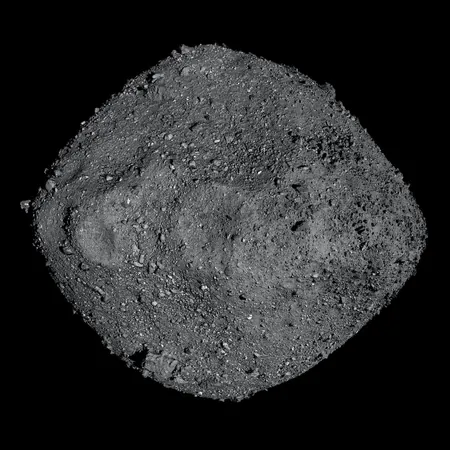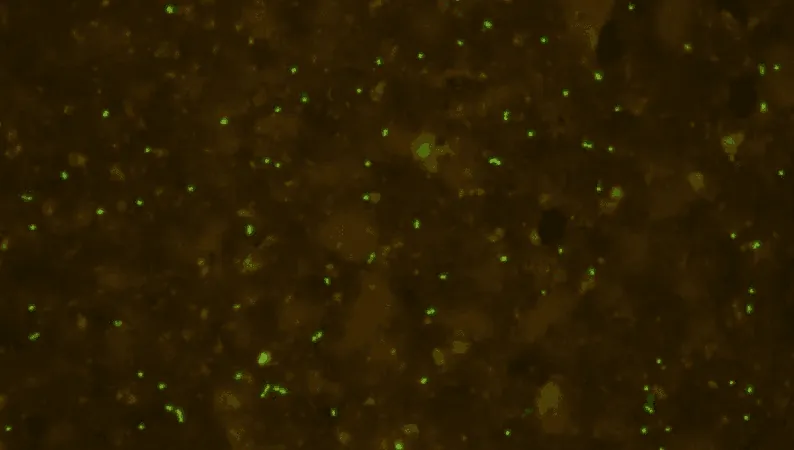
Asteroid Color Mystery Unraveled: What Bennu and Ryugu Reveal About Our Solar System
2025-08-31
Author: Rajesh
NASA's OSIRIS-REx Returns with Answers
In 2023, NASA's OSIRIS-REx spacecraft returned from its groundbreaking mission to asteroid Bennu, offering more than just ancient rocks—it brought vital clues to an intriguing cosmic puzzle that has confounded astronomers for years.
The Color Dilemma: Bennu vs. Ryugu
Two remarkably similar asteroids, Bennu and Ryugu, provide the crux of this mystery. Both composed of dark, carbon-rich materials and formed around 4.5 billion years ago during the dawn of our Solar System, you’d expect them to reflect light in identical ways. Yet, when observed, Ryugu presents a faint red hue while Bennu shines with a blue tint—a contradiction that demanded explanation.
Space Weathering: The Key to the Mystery
Purdue University’s Michelle Thompson, an expert in planetary science and space weathering, has taken on the challenge of analyzing samples from both asteroids. Her research, featured in three new studies, indicates that the difference in color can be attributed to varying stages of space weathering—a process that alters asteroid surfaces due to relentless bombardment from solar radiation, cosmic rays, and micrometeorite impacts.
The Age Factor: Why Color Differences Exist
Thompson’s pivotal findings highlight the exposure ages of surface particles from each asteroid. Grains from Ryugu have only been exposed to space for a few thousand years, while the particles from Bennu have endured for tens of thousands. This age difference reveals that these asteroids reflect two moments in the same weathering cycle: Bennu's blueness indicates advanced weathering, whereas Ryugu’s redder appearance signifies an earlier stage.
Implications for Asteroid Studies and Future Missions
With over 1.45 million known asteroids in the Solar System, reaching them all isn’t feasible. This research offers an extraordinary method of extrapolating insights about distant bodies through Earth-based analyses. Understanding how surface weathering influences an asteroid's visual characteristics paves the way for more confident target selections in future exploratory missions.
Life's Building Blocks: More Secrets from Bennu
The intriguing findings don’t stop at color. Bennu’s samples contain vital salts, including phosphates essential for life on Earth. These crucial components hint at an environment conducive to the formation of the very building blocks of life.
As Michelle Thompson says, "We are exploring the organic molecules that may have seeded life on early Earth. While we won’t find life itself, we’re examining the very elements that could have evolved into it."
Asteroids: Time Capsules of Our Origins
These celestial rocks act as time capsules, preserving the pristine conditions of the early Solar System. Unlike Earth, where geological and biological processes have altered the original ingredients, asteroids guard the fundamental materials that served as the foundations for planet formation.
Revolutionizing Space Exploration Through Sample Returns
The decoding of color mysteries from sample return missions marks a transformative moment in our understanding of space. By analyzing samples brought back to Earth, scientists can uncover secrets that are unreachable through telescopic observation, shedding light on both our Solar System's history and the potential origins of life itself.


 Brasil (PT)
Brasil (PT)
 Canada (EN)
Canada (EN)
 Chile (ES)
Chile (ES)
 Česko (CS)
Česko (CS)
 대한민국 (KO)
대한민국 (KO)
 España (ES)
España (ES)
 France (FR)
France (FR)
 Hong Kong (EN)
Hong Kong (EN)
 Italia (IT)
Italia (IT)
 日本 (JA)
日本 (JA)
 Magyarország (HU)
Magyarország (HU)
 Norge (NO)
Norge (NO)
 Polska (PL)
Polska (PL)
 Schweiz (DE)
Schweiz (DE)
 Singapore (EN)
Singapore (EN)
 Sverige (SV)
Sverige (SV)
 Suomi (FI)
Suomi (FI)
 Türkiye (TR)
Türkiye (TR)
 الإمارات العربية المتحدة (AR)
الإمارات العربية المتحدة (AR)